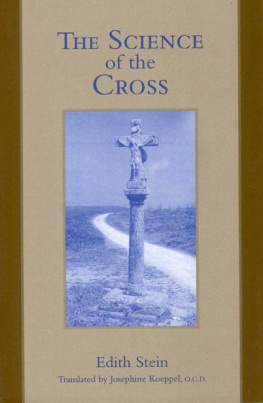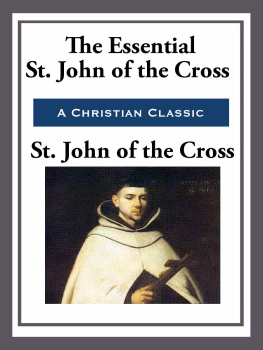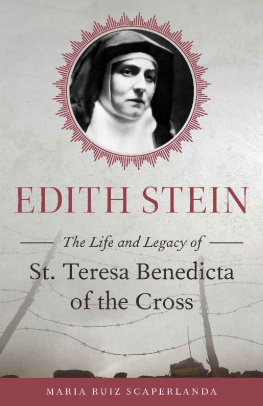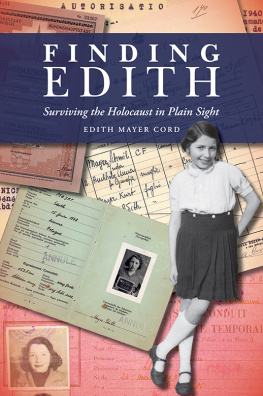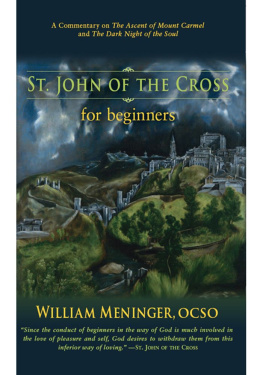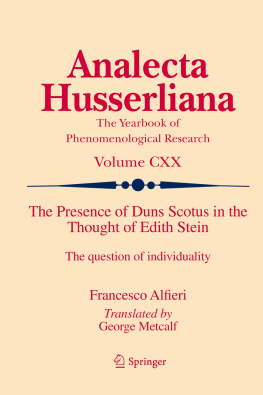The Collected Works of Edith Stein
VI
THE SCIENCE OF THE CROSS
Edith Stein
Saint Teresa Benedicta of the Cross
Discalced Carmelite
Translated by Josephine Koeppel, O.C.D.
Edited by Dr. L. Gelber and Romaeus Leuven, O.C.D.
ICS Publications Institute of Carmelite Studies The original of this work was published in German by the Archivum Carmelitanum Edith Stein under the title
Kreuzeswissenschaft, Studie ber Joannes a Cruce Band I of Edith Steins Werke Verlag Herder, Freiburg, Basel, Vienna, 1983.
Translation authorized.
Verlag Herder, Freiburg-im-Breisgau 1983. English translation copyright
Washington Province of Discalced Carmelites, Inc. 2002
Cover design by Rosemary Moak, O.C.D.S. Typesetting by Stephen Tiano Page Design & Production
Library of Congress Cataloging-in-Publication Data
Stein, Edith, Saint, 1891-1942.
[Kreuzeswissenschaft. English]
The science of the Cross / Edith Stein (Saint Teresa Benedicta of the Cross); translated by Josephine Koeppel.
p. cm. -- (The collected works of Edith Stein ; v. 6)
Includes bibliographical references (p.) and index. ISBN 0-935216-31-6
1. John of the Cross, Saint, 1542-1591. I. Koeppel, Josephine. II. Title.
BX4700.J7 S7513 2002
271'.7302--dc21
CONTENTS
THE SCIENCE OF THE CROSS
Chapters
TRANSLATORS NOTE
The great Spanish mystic, John of the Cross, was formerly little known in Germany and German-speaking countries, and Sr. Teresa Benedicta, the Carmelite whom we also remember as Edith Stein the philosopher, wished to make her sisters better acquainted with him and his mystical writings. An excellent opportunity arose on the occasion of the celebration of the fourth centenary of St. John of the Crosss birth in 1542. Edith was asked to write a kind of Festschrift for the father of Carmel, and so Science of the Cross Kreuzeswissenschaft came into existence.
In one letter, to prepare for her task, she asked for the French biography of St. John of the Cross by Pre Bruno de Jsus-Marie. It coincidentally carried a long introduction by Jacques Maritain who with his wife, Raissa, had welcomed Edith to their home in Meudon, France, September 12, 1932, on the occasion of a symposium on phenomenology and Thomism. This biography was translated into English by Fr. Benedict Zimmerman, O.C.D., of Kensington, England. I have used his translation for quotations from this work and identified them as Bruno St. John. However, this English translation (New York: Sheed and Ward, 1932) seems somewhat abridged and therefore in a number of the notes referring to Fr. Brunos work, I have given the page numbers from the French edition and referred to it as Bruno St. Jean .
A bibliography was provided in the original Kreuzeswissenschaft prepared by the editors, Fr. Romaeus Leuven, O.C.D., and Dr. Lucie Gelber. The footnote to this bibliography states that it includes all the works that Edith Stein in the course of her presentation either quotes or refers to. The Spanish works of St. John of the Cross edited by Padre Silverio, O.C.D., and another set edited by Padre Gerardo are listed. There is no mention of a German edition of St. Johns works, and in this English translation I began with the assumption that the quotations from St. John were the work of Sr. Teresa Benedicta. To insure that I would not run into problems for which there were no solutions, Sr. Christina Middendorf, during my stay in the Carmel of Cologne in 1994-95, devoted many hours of her time to go over the volume sentence by sentence to clarify any doubtful passages. After about fifty pages were cleared, I remarked what a tremendous help it would be if I could double check our work with a German translation of the works of St. John and I inquired whether, as I expected, in the intervening years since Edith wrote her book, St. Johns writings had been translated into German. A trip to the community library resulted in a surprising find. There was a set of five volumes of St. John of the Cross in German: the Ascent translated by Ambrose of St. Teresa, O.C.D., and the other four volumes translated by Aloysius of the Immaculate Conception, O.C.D. (Munich: Theatiner Verlag, 1924-29). It then became clear that Edith did not translate St. John from the Spanish because her quotations were taken from these volumes. At times, though, it was evident that she used the Spanish critical edition of Padre Gerardo to clarify some point for herself.
Another discovery was of interest. Edith was a most meticulous worker. Her paper was all of one size even when she used the blank reverse of a business letter or of a typescript of some other of her writings. Cut to uniform size, the sheets all had an inch or so at the margin, folded and creased. Opened up then, this inch served as space for Ediths notes, which gave the location of quotations from St. John. For the first thirty or forty pages of the manuscript these references were given to the German translations. Then without any explanation Edith switched to give the locations as they were to be found in Gerardos Spanish volumes.
In the few cases where the German translation differed significantly from the English, I translated from the German and gave a reference to where the text could be found in the English translation mentioned in the notes. I have translated Ediths German versions of the Spanish poetry into English, and one can find interesting variations when comparing them with other English translations.
Ediths notes are given without identification, but to distinguish my notes from hers, I placed mine in brackets and did the same for those few notes that were made by the German editors, which I identified.
Early in 1995, a good number of the original manuscripts of Ediths writings were brought from the Netherlands to the Carmel in Cologne, and it was a grace and wonderful experience to look up some puzzling phrases in the original and so to hold in ones hands the writings of the saint. This resulted in a number of notes to explain significant differences between Ediths original manuscript and the printed version in the 1953 Archivum Carmelitanum edition. A new definitive series of St. Ediths writings is currently being published in German, and the new edition of Kreuzeswissenschaft will have removed most of the errors to be found in the editions published so far. The edition used for this translation was printed in Holland in 1983. It has seemed important to include in this translation notes regarding both typographical errors and misread passages because there may be students of Ediths thought who will continue to use these earlier versions of her works and not be aware of mistakes inadvertently made by a stenographer or a typesetter.
On returning to my own Carmel in 1995, I transcribed, for the most part, Ediths references to St. Johns works as found in Gerardos critical edition into a simple statement of the book or poem, chapter or stanza, and paragraph number. The list of quotations showed that Edith included every one of St. Johns works in her commentary.
One bit of tedious effort remained to insure that no sentence had been inadvertently skipped over in the translation process. Kathleen Sullivan painstakingly compared the texts and found indeed that in three or four places a sentence had eluded me. Without her help I could not be as confident as I wanted to be that Ediths work was presented with the greatest possible accuracy.
A final word of deepest thanks goes to those who were my superiors over the years and to the sisters in my own Carmel for allowing me the time and giving me their support and encouragement especially when there was a dip in my energy level!
It has given me a world of satisfaction as I conclude this note to reflect that others occupied with Ediths writings see what I have been convinced of from the start. Science of the Cross is not an unfinished book. Perhaps Edith had some editing to add, but the essentials are all there and will reward, enrich, and delight the reader.

